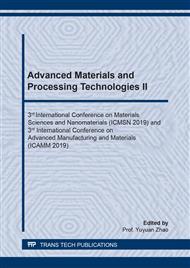p.92
p.98
p.106
p.115
p.121
p.128
p.135
p.143
p.151
Interfacial Bonding Behavior of Stainless Steel / Carbon Steel in Cold Rolling Process
Abstract:
A cylindrical indenter was designed to simulate the roller and 304 stainless steel / Q235A carbon steel plate with different roughness were bonded together. The interfacial bonding behavior was investigated by SEM, ultrasonic “C” scanning detection and nanoindentation test. The result reveal that with the increase of contact pressure between interfaces, the atoms of dissimilar metals begin to diffuse across interfaces in some regions, then form island-like bonding regions, and eventually extend to the whole interface. There are no obvious cracks on the surface of stainless steel and carbon steel after deformation. The cold roll-bonding mechanism of stainless steel and carbon steel is that elements on both sides of the interface diffuse and form a shallow diffusion layer under pressure to ensure the joint strength, and the joint bonding strength is greater than the strength of carbon steel matrix. In addition, the surface morphology of base metal has a great influence on the interfacial bonding quality. The higher surface roughness values increases the hardening degree of rough peak, which makes real contact area difficult to increase and reduce the interfacial bonding quality.
Info:
Periodical:
Pages:
121-127
Citation:
Online since:
March 2020
Authors:
Price:
Сopyright:
© 2020 Trans Tech Publications Ltd. All Rights Reserved
Share:
Citation:


